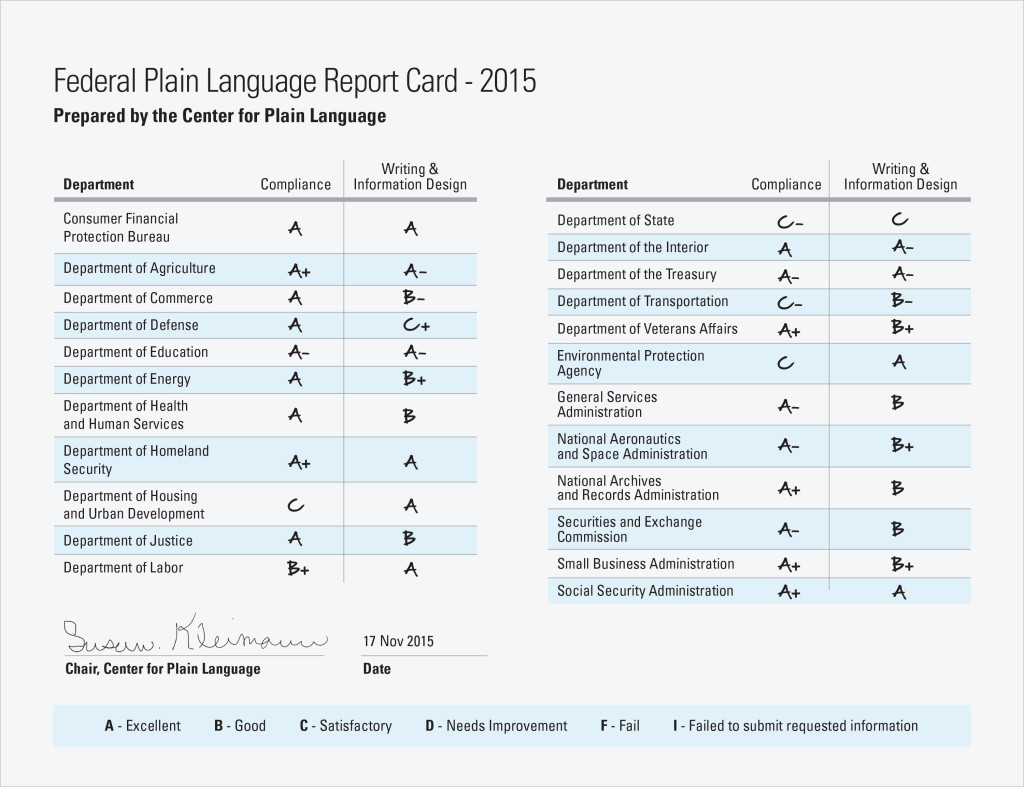No ‘As’ for effort this year, all agencies clear plain language hurdles
The Social Security Administration earned the highest grade, while eight other agencies improved this year over the last. The Center for Plain Language said no...
Agencies earned their best grades yet on an annual report card that measures their ability to write and speak in a way that the public can understand.
All 23 agencies submitted documents to the Center for Plain Language, an advocacy group that encourages departments to forgo the technical jargon in favor of understandable English, this year. They all complied with the Plain Language Act of 2010, which requires federal organizations use “plain language” for written and online documents meant for public consumption.
Eight agencies improved their grades in 2015, while four departments’ scores dropped, according to the 2015 Federal Plain Language Report Card.
For the second consecutive year, the Social Security Administration earned the highest grade of any other agency — an A+.
The Education Department made the most improvements this year, jumping from a D to A- grade in the compliance category and a C to A- grade for writing and information design.
The State and Interior departments also made drastic compliance improvements this year. Interior improved its grade from a F to A, while State moved from F to C-.
“These folks are there to serve the public,” Rep. Dave Loebsack (D-Iowa) said during a call with reporters Nov. 17. “One of the best ways that they can serve the public as well as they can, is to make sure that they can communicate with the public properly and the public can understand what it is that they do.”
The Defense and State departments need the most work. They earned C+ and C grades, respectively, in their writing and overall document design and organization, the Center said.

The Center looked at each agency’s “About Us” page, as well as two “public-facing” documents that each department submitted on their own.
For the first time, the Center used human readers to judge agencies’ writing samples, in addition to Acrolinx, a computerized tool that measures stylistic and readability problems.
Overall, agencies’ actual writing improved, but the design and organization of those written and online documents needs some work, said Annetta Cheek, board chair at the Center for Plain Language.
Typically, federal employees wrote for their boss or an attorney, not the intended audience, she said.
“There’s been very little attention given to the public that’s the user of these federal documents,” Cheeke said. “Getting the government to write in plain language is really a culture change to get people to start thinking about the reader.”
Chris Crane, a board member and the Center’s lead for Plain Language Report Card, said agencies’ overall improvement shows a broader shift in the government’s interest and emphasis on customer service.
“The reader is the customer, and the writer works harder so the reader doesn’t have to,” he said.
In the future, the Center will look at other kinds of agency documents, like high-usage forms or tests, which might be more challenging for the agencies.
“We’re just skimming the top level of stuff that’s most accessible to the public, and as you go down deeper, it tends to get worse and worse,” Cheek said.
But since the Center began releasing its annual score cards four years ago, federal employees tell Cheek they’re noticing a difference in their own work.
“We know it didn’t create a revolution,” Cheek said. “You’re not going to change all those federal writers overnight. But a very typical comment would be, ‘my managers used to ignore me, and now they come and ask my advice.'”
Copyright © 2025 Federal News Network. All rights reserved. This website is not intended for users located within the European Economic Area.
Nicole Ogrysko is a reporter for Federal News Network focusing on the federal workforce and federal pay and benefits.
Follow @nogryskoWFED



